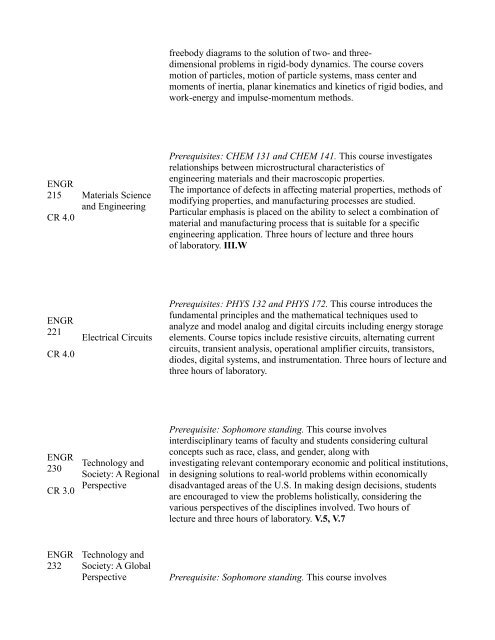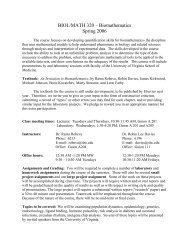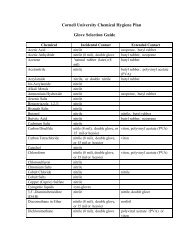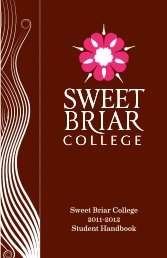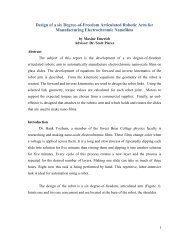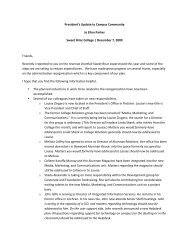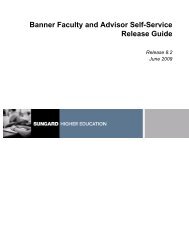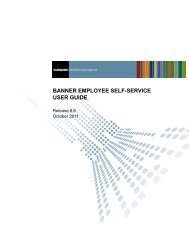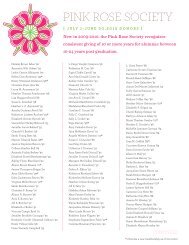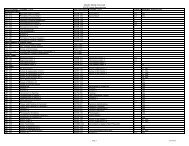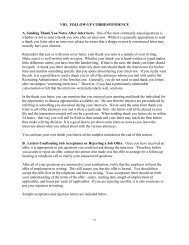- Page 2 and 3:
Academic Advising The advising prog
- Page 4 and 5:
Alpha Psi Omega In 2001, the Alpha
- Page 6 and 7:
the best short story entered in the
- Page 8 and 9:
Jessica Steinbrenner Molloy Award h
- Page 10 and 11:
curricular activities. Technology T
- Page 12 and 13:
Sweet Briar’s Junior Year in Fran
- Page 14 and 15:
University of Oxford, England, for
- Page 16 and 17:
ecorded in her journal by relating
- Page 18 and 19:
The award of the Honors Degree is n
- Page 20 and 21:
• expected date of completion of
- Page 22 and 23:
may be adjusted on an as-needed bas
- Page 24 and 25:
B Good 3.0 Yes Yes B- Good (-) 2.7
- Page 26 and 27:
Grade Appeal Policy A student who f
- Page 28 and 29:
other means of assessment. Students
- Page 30 and 31:
exempting from the requirement must
- Page 32 and 33:
York at Albany Maria Celeste Delgad
- Page 34 and 35:
B.S. Clarkson University Steve Bail
- Page 36 and 37:
10th Grade English Foreign Language
- Page 38 and 39:
Students who transfer to Sweet Bria
- Page 40 and 41:
Fifth-Year Plan — Any alumna of S
- Page 42 and 43:
Sweet Briar College adheres to the
- Page 44 and 45:
full year of successful college wor
- Page 46 and 47:
Students who turn 23 years of age p
- Page 48 and 49:
The Laura Buckham Book Award was es
- Page 50 and 51:
The Mathematical Sciences Award is
- Page 52 and 53:
committees of the Board of Director
- Page 54 and 55:
Mary Johnson Nelson ’64, B.A. Pre
- Page 56 and 57:
This non-refundable fee will be cre
- Page 58 and 59:
Music Department facilities for pra
- Page 60 and 61:
Course Catalog Archives The followi
- Page 62 and 63:
Professor of Education and Cameron
- Page 64 and 65:
Suzanne C. Calvert Assistant Profes
- Page 66 and 67:
B.A. University of Florida Carlos A
- Page 68 and 69:
Professor of German and Cameron Fel
- Page 70 and 71:
Associate Professor of History B.A.
- Page 72 and 73:
Visiting Assistant Professor of Env
- Page 74 and 75:
Camilla Smith Assistant Professor o
- Page 76 and 77:
Professor of Chemistry Emerita Reyn
- Page 78 and 79:
Elisabeth S. Muhlenfeld President E
- Page 80 and 81:
If the student is the recipient of
- Page 82 and 83:
If a student wishes to be considere
- Page 84 and 85:
introduced to practices of scholars
- Page 86 and 87:
International Programs & Study Abro
- Page 88 and 89:
provides one full term’s academic
- Page 90 and 91:
of public law, American politics, j
- Page 92 and 93:
cultures • Takes an historical ap
- Page 94 and 95:
Physical Activity Requirement It is
- Page 96 and 97:
element of the course content 2. Th
- Page 98 and 99:
Student Access — Students may rev
- Page 100 and 101:
1. The modification must be directl
- Page 102 and 103:
members are selected for their expe
- Page 104 and 105:
of professional level workshops and
- Page 106 and 107:
Athletics At Sweet Briar, athletics
- Page 108 and 109:
of Modern Languages and Literatures
- Page 110 and 111:
other topics. they see two more pla
- Page 112 and 113:
Sweet Briar’s Mission Sweet Briar
- Page 114 and 115:
Rotating art exhibitions are resear
- Page 116 and 117:
itual, symbols, cosmological system
- Page 118 and 119:
Choose 1 of the following courses:
- Page 120 and 121:
Choose 2 additional three-credit co
- Page 122 and 123:
Biology Modern biology has evolved
- Page 124 and 125:
Required: 1. A bachelor of arts or
- Page 126 and 127:
(21-22 semester hours) Required: BU
- Page 128 and 129:
(58 semester hours) Required prereq
- Page 130 and 131:
translation, offer a wider conspect
- Page 132 and 133:
Required: CLAS 207 (3) The Rise and
- Page 134 and 135:
DANC 109 (1) Beginning Jazz DANC 11
- Page 136 and 137:
ased, best practice instruction to
- Page 138 and 139:
EDUC 211 (3) Teaching Diverse Learn
- Page 140 and 141:
ENVR 143, 203, 244, 309, and 433. T
- Page 142 and 143:
courses below for additional requir
- Page 144 and 145:
ENGL 329 (3) American Romanticism E
- Page 146 and 147:
level writing-intensive literature
- Page 148 and 149:
Environmental Studies The Departmen
- Page 150 and 151:
HNRS 399 (3) Summer Honors Research
- Page 152 and 153:
The Fine Arts Program Required: Cho
- Page 154 and 155:
Senior Exercise: FREN 452 (3) Senio
- Page 156 and 157:
Choose 1 of the following 9-credit
- Page 158 and 159:
course given in English may be cred
- Page 160 and 161:
History History is the study of the
- Page 162 and 163:
HIST 143 (3) Early Modern Europe, 1
- Page 164 and 165:
elated to a theme, current news eve
- Page 166 and 167:
Interdisciplinary Studies INTD 107
- Page 168 and 169:
Master of Arts in Teaching (see Edu
- Page 170 and 171:
(60-61 semester hours) Required: CH
- Page 172 and 173:
Teacher Licensure Students seeking
- Page 174 and 175:
ENGL 319 (3) Chaucer ENGL 322 (3) R
- Page 176 and 177:
No course being counted toward the
- Page 178 and 179:
courses must be at the 300-level. N
- Page 180 and 181:
SPAN 330 (3) Topics in Hispanic Cul
- Page 182 and 183:
MUSC 312 (3) Art Song The Music Min
- Page 184 and 185:
Dance Music Theatre Music Theatre A
- Page 186 and 187:
DANC 463 (3) Senior Project Choose
- Page 188 and 189:
(18 semester hours) Required: MUSC
- Page 190 and 191:
option may be exercised for courses
- Page 192 and 193:
Senior Exercise: PHIL 452 (3) Senio
- Page 194 and 195:
activities are offered including: h
- Page 196 and 197:
Physics Physics is the most fundame
- Page 198 and 199:
semester hours may be satisfied by
- Page 200 and 201:
MATH 113 (3) Precalculus MATH 123 (
- Page 202 and 203:
RELG 244 (3) Christianity RELG 255
- Page 204 and 205:
Riding Program Courses There is an
- Page 206 and 207:
The Sociology Minor The Sociology M
- Page 208 and 209:
Choose 1 of the following courses:
- Page 210 and 211:
Students interested in the studio a
- Page 212 and 213:
The Musical Theatre Minor for the m
- Page 214 and 215:
Choose 1 of the following courses:
- Page 216 and 217:
CR 3.0 archaeology and a survey of
- Page 218 and 219:
modernities. Offered every two year
- Page 220 and 221:
course is taken on a P/CR/NC gradin
- Page 222 and 223:
urials vary cross-culturally. In th
- Page 224 and 225:
creation and management of performi
- Page 226 and 227:
with a faculty member who will act
- Page 228 and 229:
alternate years. III.W, V.6a ARTH 2
- Page 230 and 231:
ARTH 303 CR 3.0 Seminar on Women Ar
- Page 232 and 233:
ARTH 361 CR 1.0 Special Study Prere
- Page 234 and 235:
CR 3.0 Prerequisite: Arts 101, Arts
- Page 236 and 237:
CR 3.0 making thrown three-dimensio
- Page 238 and 239:
ARTS 320 CR 3.0 Etching Prerequisit
- Page 240 and 241:
ASIA 218 CR 3.0 Chinese Cinema Prer
- Page 242 and 243:
CR 4.0 An introduction to organisma
- Page 244 and 245:
and three hours laboratory or field
- Page 246 and 247: BIOL 320 CR 4.0 Biomathematics Prer
- Page 248 and 249: CR 1.0 A seminar on topics in biolo
- Page 250 and 251: CR 2.0 students exposure to all asp
- Page 252 and 253: BUSN 326 CR 3.0 Project Selection a
- Page 254 and 255: critical importance of strategy for
- Page 256 and 257: an introduction to proteolytic and
- Page 258 and 259: compounds and biomolecules. Thermod
- Page 260 and 261: analytical approach to problem solv
- Page 262 and 263: focusing on some of the most import
- Page 264 and 265: III.W, V.1 CLAS 318 CR 3.0 Topics i
- Page 266 and 267: DANC 111 CR 1.0 Beginning Modern Da
- Page 268 and 269: including work with dance on camera
- Page 270 and 271: a P/CR/NC grading option. III.Q ECO
- Page 272 and 273: economic tools such as benefit-cost
- Page 274 and 275: CR 3.0 and secondary school teacher
- Page 276 and 277: EDUC 461 CR 1.0 Independent Study P
- Page 278 and 279: literature. This course will invest
- Page 280 and 281: Although literary villains often em
- Page 282 and 283: observation and practice. ENGL 235
- Page 284 and 285: are the advantages and risks of fir
- Page 286 and 287: Carson McCullers, Lorraine Hansberr
- Page 288 and 289: V.2 ENGL 322 CR 3.0 Romance and Ren
- Page 290 and 291: ENGL 340 CR 3.0 The Sacred and the
- Page 292 and 293: ENGL 371 CR 3.0 Nonfiction Workshop
- Page 294 and 295: CR 3.0 English/creative writing maj
- Page 298 and 299: techniques are employed. ENGR 323 C
- Page 300 and 301: ENGR 415 CR 4.0 Systems Modeling an
- Page 302 and 303: and climate change. The nature and
- Page 304 and 305: CR 3.0 I Prerequisite: Permission r
- Page 306 and 307: independent research, develop clear
- Page 308 and 309: CR 3.0 and the movies, will be offe
- Page 310 and 311: FREN 329 CR 3.0 Semiotics of French
- Page 312 and 313: GNDR 361 CR 3.0 Special Study Prere
- Page 314 and 315: financial markets, particularly gov
- Page 316 and 317: the role of the West. Offered alter
- Page 318 and 319: GOVT 356 CR 3.0 War and Peace in Af
- Page 320 and 321: GREK 318 CR 3.0 Topics In Greek Lit
- Page 322 and 323: CR 3.0 Composition Prerequisites: G
- Page 324 and 325: supervision of a faculty member. GR
- Page 326 and 327: HIST 105 CR 3.0 Prerequisite: Open
- Page 328 and 329: associated with Nazi Germany, inclu
- Page 330 and 331: paying special attention to the cha
- Page 332 and 333: environments being mapped and explo
- Page 334 and 335: HIST 333 CR 3.0 The Great War in Eu
- Page 336 and 337: CR 3.0 Prerequisites: One 100-level
- Page 338 and 339: HNRS 115 What the Mayans Know in 20
- Page 340 and 341: or minor in English/creative writin
- Page 342 and 343: HNRS 309 Sacraments and Civil Union
- Page 344 and 345: INTD 108 American Economies in the
- Page 346 and 347:
CR 3.0 This capstone course is co-r
- Page 348 and 349:
LATN 202 CR 3.0 Intermediate Latin
- Page 350 and 351:
Vergil’s timeless corpus. V.2, V.
- Page 352 and 353:
MATH 205 CR 3.0 Applied Statistics
- Page 354 and 355:
CR 3.0 to constructing rigorous mat
- Page 356 and 357:
students select and research topics
- Page 358 and 359:
fee required. MUSC 181 CR 2.0 Appli
- Page 360 and 361:
epeated for credit. V.6b MUSC 193 C
- Page 362 and 363:
Williams, Danny Elfman, Howard Shor
- Page 364 and 365:
hythmic aspects, matters of texture
- Page 366 and 367:
ole they play in mechanisms of inju
- Page 368 and 369:
PHED 161 CR 2.0 Special Study Prere
- Page 370 and 371:
member. PHED 377 CR 3.0 Internship
- Page 372 and 373:
Prerequisite: PHIL 115 or PHIL 129.
- Page 374 and 375:
PHlL 361 CR 3.0 Special Study Prere
- Page 376 and 377:
and optics. III.Q, V.8a PHYS 202 CR
- Page 378 and 379:
PHYS 313 CR 3.0 Quantum Mechanics P
- Page 380 and 381:
are engaged. It is not intended to
- Page 382 and 383:
small group of students under the i
- Page 384 and 385:
PSYC 328 CR 3.0 Human Neuropsycholo
- Page 386 and 387:
alternate years. PSYC 432 CR 4.0 Ps
- Page 388 and 389:
RDPR 186 Jumping Fundamentals II IV
- Page 390 and 391:
RDPR 365 Field Riding and Jumping I
- Page 392 and 393:
RELG 111 CR 3.0 Good and Evil What
- Page 394 and 395:
RELG 244 CR 3.0 Christianity An his
- Page 396 and 397:
taken over some or many of the trad
- Page 398 and 399:
SOCI 220 CR 3.0 Community Prerequis
- Page 400 and 401:
examine the range of sociological t
- Page 402 and 403:
SPAN 201 CR 3.0 Intermediate Spanis
- Page 404 and 405:
CR 3.0 Identity Prerequisite: SPAN
- Page 406 and 407:
SPAN 461 CR 1.0 Independent Study P
- Page 408 and 409:
form, content, and style. Offered a
- Page 410 and 411:
CR 3.0 and 21st Centuries genres an


